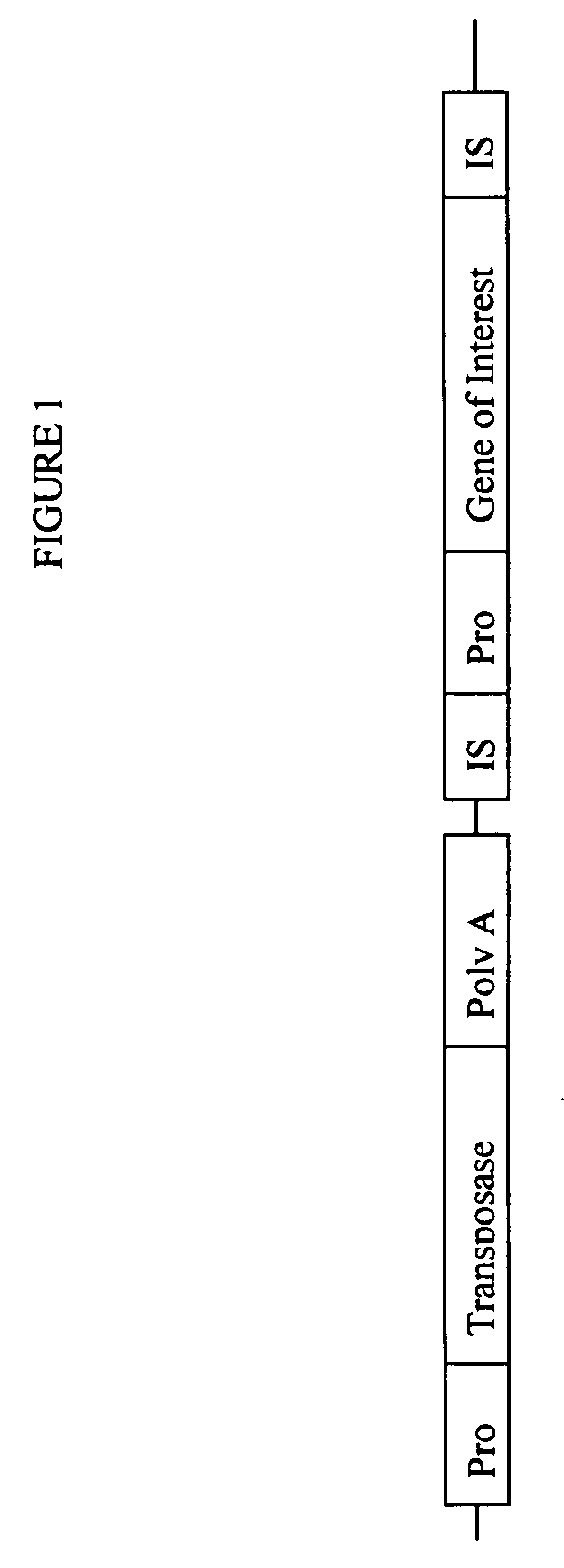Gene regulation in transgenic animals using a transposon-based vector
a transposon-based vector and gene regulation technology, applied in vectors, immunoglobulins against animals/humans, peptides, etc., can solve the problems of low gene incorporation rate, unstable gene incorporation, and only partially effective therapies, and achieve high transgene copy numbers and high efficiency
- Summary
- Abstract
- Description
- Claims
- Application Information
AI Technical Summary
Benefits of technology
Problems solved by technology
Method used
Image
Examples
example 1
Preparation of Transposon-Based Vector PTnMod
[0200]A vector was designed for inserting a desired coding sequence into the genome of eukaryotic cells, given below as SEQ ID NO:1. The vector of SEQ ID NO:1, termed pTnMod, was constructed and its sequence verified.
[0201]This vector employed a cytomegalovirus (CMV) promoter. A modified Kozak sequence (ACCATG) (SEQ ID NO:13) was added to the promoter. The nucleotide in the wobble position in nucleotide triplet codons encoding the first 10 amino acids of transposase was changed to an adenine (A) or thymine (T), which did not alter the amino acid encoded by this codon. Two stop codons were added and a synthetic polyA was used to provide a strong termination sequence. This vector uses a promoter designed to be active soon after entering the cell (without any induction) to increase the likelihood of stable integration. The additional stop codons and synthetic polyA insures proper termination without read through to potential genes downstream...
example 2
Preparation of Transposon-Based Vector pTnMod (CMV / Red)
[0229]A vector was designed for inserting a reporter gene (DsRed) under the control of the CMV promoter into the genome of vertebrate cells given below as SEQ ID NO:2. The reporter gene chosen was the DsRed gene, driven by the immediate early cytomegalovirus promoter, to produce a plasmid called pTnCMV / DsRed. The DsRed gene product is a red fluorescent protein from an IndoPacific sea anemone, Discosoma sp., which fluoresces bright red at 558 nm. It is to be understood that the reporter gene, i.e., the DsRed gene, is only one embodiment of the present invention and that any gene of interest may be inserted into the plasmid in place of the DsRed reporter gene in any Experiment described herein.
[0230]The vector of SEQ ID NO:2, named pTnMod (CMV / Red), was constructed, and its sequence verified by re-sequencing. SEQ ID NO:2, pTnMod (CMV / Red), includes the following components:
[0231]Base pairs 1-130 are a remainder of F1(−) on from pB...
example 3
Preparation of Transposon-Based Vector pTnMod (Oval / Red)—Chicken
[0255]A vector was designed for inserting a reporter gene (DsRed) under the control of the ovalbumin promoter, and including the ovalbumin signal sequence, into the genome of a bird. One version of this vector is given below as SEQ ID NO:3. The vector of SEQ ID NO:3, named pTnMod (Oval / Red)—Chicken, includes chicken ovalbumin promoter and signal sequences.
[0256]SEQ ID NO:3, pTnMod (Oval / Red)—Chicken, includes the following components:
[0257]Base pairs 1-130 are a remainder of F1(−) on from pBluescriptll sk(−) (Stratagene), corresponding to bp 1-130 of pBluescriptll sk(−).
[0258]Base pairs 131-132 are a residue from ligation of restriction enzyme sites used in constructing the vector.
[0259]Base pairs 133-1777 are the CMV promoter / enhancer taken from vector pGWiz (Gene Therapy Systems, corresponding to bp 229-1873 of pGWiz.
[0260]Base pairs 1778-1779 are a residue from ligation of restriction enzyme sites used in constructin...
PUM
| Property | Measurement | Unit |
|---|---|---|
| volume | aaaaa | aaaaa |
| volume | aaaaa | aaaaa |
| volume | aaaaa | aaaaa |
Abstract
Description
Claims
Application Information
 Login to View More
Login to View More - R&D
- Intellectual Property
- Life Sciences
- Materials
- Tech Scout
- Unparalleled Data Quality
- Higher Quality Content
- 60% Fewer Hallucinations
Browse by: Latest US Patents, China's latest patents, Technical Efficacy Thesaurus, Application Domain, Technology Topic, Popular Technical Reports.
© 2025 PatSnap. All rights reserved.Legal|Privacy policy|Modern Slavery Act Transparency Statement|Sitemap|About US| Contact US: help@patsnap.com



